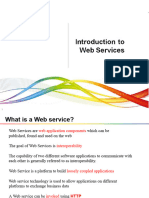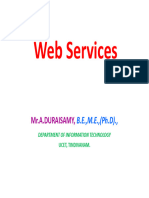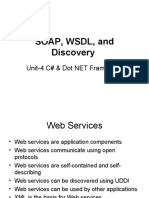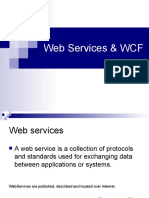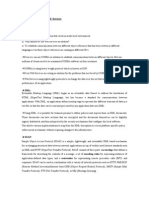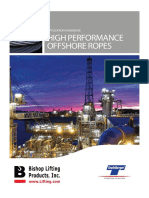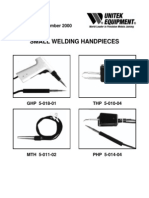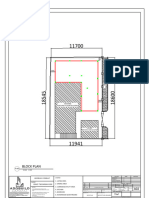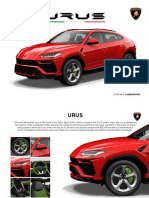It2353 - Web Technology
It2353 - Web Technology
Uploaded by
vkthikCopyright:
Available Formats
It2353 - Web Technology
It2353 - Web Technology
Uploaded by
vkthikOriginal Title
Copyright
Available Formats
Share this document
Did you find this document useful?
Is this content inappropriate?
Copyright:
Available Formats
It2353 - Web Technology
It2353 - Web Technology
Uploaded by
vkthikCopyright:
Available Formats
IT2353 - WEB TECHNOLOGY PART - A 1. What is SOAP?
(Simple Object Access Protocol) SOAP is an XML based protocol that allows applications to easily over the internet using XML documents called AOAP message. A SOAP message contains an envelope, which is a structure that describes a method call. A SOAP messages body contains either a request or a response. A request messages body contains a Remote Procedure Call (RPC), which is a request for another machine to perform task. The RPC specifies the method to be invoked and any parameters the method takes. The application sends the SOAP message via an HTTP POST. A SOAP response message is an HTTP response document that contains the results from the methods call (e.g. return values, error messages.) 2. WHAT IS THE USE OF WEB SERVICES? Web services encompass a set of related standards that can enable two computer The data is passed back and forth using standard protocols such as HTTP, the same protocol used to transfer ordinary web pages. Web services operate using open, text-based standards that enable components written in different languages and on different platforms to communicate. They are ready to use pieces of software on the Internet. XML, SOAP, Web Services Description Language (WSDL) and Universal Description, Discovery and Integration (UDDI) are the standards on which web services rely. UDDI is another XML based format that enables developers and business to publish and locate Web services on a network. 3. What do you mean by JDBC? JDBC Part of the Java Development Kit which defines an application-programming interface for Java for standard SQL access to databases from Java programs. 4. Define ODBC. It is a standard for accessing different database systems. There are interfaces for Visual Basic, Visual C++, SQL and the ODBC driver pack contains drivers for the Access, Paradox, dBase, Text, Excel and Retrieve databases. 5. What are the advantages of web services? Reusable application-components. There are things applications need very often. So why make these over and over again? Web services can offer application-components like: currency conversion, weather reports, or even language translation as services. Connect existing software. Web services can help to solve the interoperability problem by giving different applications a way to link their data. With Web services you can exchange data between different applications and different platforms. 6. List out some web service technologies? XML,
SOAP, WSDL 7. What is XML ? Extensible markup language. It offer a standard, flexible and inherently extensible data format, XML significantly reduces the burden of deploying the many technologies needed to ensure the success of Web services. 8. What is SOAP? Service Oriented Architecture Protocol. It provides a standard, extensible, composable framework for packaging and exchanging XML messages. In the context of this architecture, SOAP also provides a convenient mechanism for referencing capabilities (typically by use of headers). 9. What is WSDL? Web Services Description Language WSDL is a language for describing Web services. WSDL describes Web services starting with the messages that are exchanged between the requester and provider agents. The messages themselves are described abstractly and then bound to a concrete network protocol and message format. 10. What are Web Services? Web services are application components Web services communicate using open protocols Web services are self-contained and self-describing Web services can be discovered using UDDI Web services can be used by other applications XML is the basis for Web services 11.How Does web services Work? The basic Web services platform is XML + HTTP. XML provides a language which can be used between different platforms and programming languages and still express complex messages and functions. The HTTP protocol is the most used Internet protocol. 12. WHAT ARE THE VARIOUS Web services platform elements? SOAP (Simple Object Access Protocol) UDDI (Universal Description, Discovery and Integration) WSDL (Web Services Description Language) 13. WHAT ARE THE TYPES OF Web SERVICES AND ITS USES? Reusable application-components. There are things applications need very often. So why make these over and over again? Web services can offer application-components like: currency conversion, weather reports, or even language translation as services. Connect existing software. Web services can help to solve the interoperability problem by giving different applications a way to link their data. With Web services you can exchange data between different applications and different platforms.
14. WRITE SHORT NOTES ON Web Services Technologies? Web service architecture involves many layered and interrelated technologies. There are many ways to visualize these technologies, just as there are many ways to build and use Web services. 15. WRITE SHORT NOTES ON SOAP. SOAP 1.2 provides a standard, extensible, composable framework for packaging and exchanging XML messages. In the context of this architecture, SOAP 1.2 also provides a convenient mechanism for referencing capabilities (typically by use of headers). [SOAP 1.2 Part 1] defines an XML-based messaging framework: a processing model and an exensibility model. SOAP messages can be carried by a variety of network protocols; such as HTTP, SMTP, FTP, RMI/IIOP, or a proprietary messaging protocol. 16. DEFINE WSDL. WSDL 2.0[WSDL 2.0 Part 1] is a language for describing Web services. WSDL describes Web services st arting with the messages that are exchanged between the requester and provider agents. The messages themselves are described abstractly and then bound to a concrete network protocol and message format. 17. Draw the architecture of UDDI. 18. WRITE SHORT NOTES ON UDDI Universal Description, Discovery, and Integration (UDDI) The directory shown in the above figure could be a UDDI registry. The UDDI registry is intended to eventually serve as a means of \"discovering\" Web Services described using WSDL . The idea is that the UDDI registry can be searched in various ways to obtain contact information and the Web Services available for various organizations. How much \"discovery\" will be used in the early days of Web Services is open to discussion. Nevertheless, even without the discovery portion, the UDDI registry is a way to keep up-to-date on the Web Services your organization currently uses. More on Universal Description, Discovery, and Integration (new window). An alternative to UDDI is the ebXML Registry (new window). 19. EXPLAIN DTD for XML Schemas XML documents are processed by applications Applications have assumptions about XML documents DTDs allow to formalize some of these constraints Part of the constraint checking must still be programmed 20. WHAT ARE Modeling DTDs.? Data models can be mapped to many different DTDs What is a good DTD? What is a bad DTD? How does the DTD affect further processing 21. WHAT ARE THE SOAP Related Technologies?
SOAP is a simple XML-based protocol to let applications exchange information over HTTP. In our SOAP tutorial, you will learn what SOAP is, and how it uses XML to exchange information between applications. 22. DEFINE SOAP structure SOAP once stood for \'Simple Object Access Protocol\' but this acronym was dropped with Version 1.2 of the standard.[1] Version 1.2 became a W3C recommendation on June 24, 2003. The acronym is sometimes confused with SOA, which stands for Service-oriented architecture; however SOAP is different from SOA. 23. What is SOAP? SOAP stands for Simple Object Access Protocol SOAP is a communication protocol SOAP is for communication between applications SOAP is a format for sending messages SOAP communicates via Internet SOAP is platform independent SOAP is language independent SOAP is based on XML SOAP is simple and extensible SOAP allows you to get around firewalls PART B 1. EXPLAIN RPC. 2. WRITE SHORT NOTES ON JAX. 3. EXPLAIN THE CONCEPT OF WEB SERVICES. 4. EXPLAIN XML SCHEMA WITH AN EXAMPLE. 5. How to build the web applications? Explain the steps ? 6. EXPLAIN SOAP CONCEPTS. 7. What are the various session tracking mechanisms. Explain with example . 8. Develop the web page for student management system using WEB SERVICES. 9. Develop the web page for library management system using WEB SERVICES. 10. Develop the web page for railway reservation system using WEB SERVICES. 11. Explain Web Services ARCHITECTURE. 12. Consider a hospital system. Write a PHP program to consolidate and show the bill to be paid by the in-patients(Assume you own data) 13. EXPLAIN SOAP BUILDING BLOCKS. 14. WRITE A PROGRAM FOR ANY TWO WEBSERVICES. 15. HOW TO STORE THE JAVA OBJECTS AS FILES 16. EXPLAIN SERIALIZATION. 17. EXPLAIN JDBC CONCEPTS. 18. EXPLAIN DATABASES AND SERVLET CONCEPTS.
You might also like
- Solution Manual For Data Abstraction and Problem Solving With Java Walls and Mirrors 3rd Edition Janet Prichard ISBN 0132122308 9780132122306Document8 pagesSolution Manual For Data Abstraction and Problem Solving With Java Walls and Mirrors 3rd Edition Janet Prichard ISBN 0132122308 9780132122306vkthikNo ratings yet
- WT (U5)Document42 pagesWT (U5)Jothi Shri.RNo ratings yet
- AWT NOTES Unit-1Document8 pagesAWT NOTES Unit-1SHAILESH SOKASHENo ratings yet
- Web Service2Document15 pagesWeb Service2Akshay ArNo ratings yet
- Unit - 3Document7 pagesUnit - 3ashookNo ratings yet
- What Are The Advantages of Web Service ?Document5 pagesWhat Are The Advantages of Web Service ?yourreddyNo ratings yet
- What Are The Components of Web Services?: Course On Getting Started With XMLDocument4 pagesWhat Are The Components of Web Services?: Course On Getting Started With XMLsrihariNo ratings yet
- Web Technologies and ServicesDocument8 pagesWeb Technologies and ServicesMahesh UmaNo ratings yet
- Web ServicesDocument35 pagesWeb ServicesfarhanamfkNo ratings yet
- 53_P16CS22_2020051902364876 (1)-15-32Document18 pages53_P16CS22_2020051902364876 (1)-15-32udccssanthiyaNo ratings yet
- Web ServicesDocument4 pagesWeb Servicessandeepjen8547No ratings yet
- Unit-6 Web Service 2Document25 pagesUnit-6 Web Service 2Rahul GuptaNo ratings yet
- 5 3 Web Services SOAP UDDI WSDL (Compatibility Mode)Document98 pages5 3 Web Services SOAP UDDI WSDL (Compatibility Mode)prakash SNo ratings yet
- Final Semantic Web Unit2 - QuestionsandAnswer BookletDocument17 pagesFinal Semantic Web Unit2 - QuestionsandAnswer Bookletvanaprabhu01No ratings yet
- unit-3 cloudDocument25 pagesunit-3 cloudjacqulinehaniNo ratings yet
- Unit 6 MWADocument23 pagesUnit 6 MWAwaghuletanishNo ratings yet
- Bca Cc Unit6Document23 pagesBca Cc Unit6sagar.adhikary675No ratings yet
- API BasicsDocument17 pagesAPI BasicsArun prakash RavelaNo ratings yet
- Web ServicesDocument12 pagesWeb Servicesshrijal1813111045No ratings yet
- What Are Web Services?Document7 pagesWhat Are Web Services?triveni23No ratings yet
- Webservices Questions What Is Web Services?Document6 pagesWebservices Questions What Is Web Services?Anonymous BbZceWkVnNo ratings yet
- SOAP, WSDL, and Discovery: Unit-4 C# & Dot NET FrameworkDocument23 pagesSOAP, WSDL, and Discovery: Unit-4 C# & Dot NET FrameworkanandkarurNo ratings yet
- Web Services Primer: Back Tutorial Home NextDocument2 pagesWeb Services Primer: Back Tutorial Home NextdotheanhdotramydoanNo ratings yet
- What Is Web ServiceDocument25 pagesWhat Is Web ServiceLaramaNo ratings yet
- Web Services PDFDocument8 pagesWeb Services PDFShaba 007100% (1)
- Q.2 Explain The Features of WCF in Detail?: List Advantage and Disadvantage of SoapDocument6 pagesQ.2 Explain The Features of WCF in Detail?: List Advantage and Disadvantage of Soapyagyesh trivediNo ratings yet
- Web ServiceDocument6 pagesWeb Serviceashish98kuNo ratings yet
- Web Services Quick GuideDocument11 pagesWeb Services Quick Guidemrinalini singhNo ratings yet
- SoapDocument6 pagesSoapjay4smileNo ratings yet
- MAD Chapter - 3: Web Services For Mobile DevicesDocument25 pagesMAD Chapter - 3: Web Services For Mobile DevicesM N.B.B.ChariNo ratings yet
- Unit-6 Web ServicesDocument20 pagesUnit-6 Web ServicesRahul GuptaNo ratings yet
- XML and SOAPDocument30 pagesXML and SOAPAnnaDumitracheNo ratings yet
- Example: Web ServicesDocument4 pagesExample: Web ServicesTudoseVladNo ratings yet
- WebservicesDocument45 pagesWebservicesapi-3875928No ratings yet
- Unit 4Document13 pagesUnit 42317029madhuNo ratings yet
- JMeter Performance TestingDocument3 pagesJMeter Performance Testingram4uintpt2No ratings yet
- Clouding Computing (UNIT - II)Document18 pagesClouding Computing (UNIT - II)Safalta SinghNo ratings yet
- Web Services Interview Questions: Click HereDocument34 pagesWeb Services Interview Questions: Click Heremandar_pise6244No ratings yet
- Web Services: A Standard Manner of Representing DataDocument8 pagesWeb Services: A Standard Manner of Representing DataMarcelo Pozo FritzNo ratings yet
- HOLIDAY HW OF COMPUTERDocument13 pagesHOLIDAY HW OF COMPUTERpragatisingh8972No ratings yet
- Web Services & WCF: AnkitDocument18 pagesWeb Services & WCF: AnkitnramuduNo ratings yet
- Web Services & WCF: Arun KumarDocument18 pagesWeb Services & WCF: Arun Kumarshakti_arun9998911No ratings yet
- Expose Client ServeurDocument16 pagesExpose Client ServeurjohndavisambassaNo ratings yet
- Unit 4Document50 pagesUnit 4SAJITHABANU SNo ratings yet
- Module 3Document6 pagesModule 3OneTeam Universal PhilippinesNo ratings yet
- Questions-And-Answers/ Question 1: What Is WCF?: AnswerDocument78 pagesQuestions-And-Answers/ Question 1: What Is WCF?: AnsweramitdhNo ratings yet
- Web ServiceDocument3 pagesWeb ServicegmkprasadNo ratings yet
- Web Service: A Brief IntroductionDocument11 pagesWeb Service: A Brief IntroductionsundaramkumarNo ratings yet
- Introduction To Web ServicesDocument18 pagesIntroduction To Web ServicesSundeep VallabhajosyulaNo ratings yet
- Documentation Web ServicesDocument7 pagesDocumentation Web ServicessatyanarayanaNo ratings yet
- Cloud Computing Unit 2Document19 pagesCloud Computing Unit 2info.mountblueNo ratings yet
- Web Services Overview: Francisco Curbera IBM T.J. Watson Research CenterDocument29 pagesWeb Services Overview: Francisco Curbera IBM T.J. Watson Research CenterElizabeth DibanadaneNo ratings yet
- What Is The Web Service Protocol Stack?: Yodlee ConfidentialDocument4 pagesWhat Is The Web Service Protocol Stack?: Yodlee ConfidentialGRBPrasadNo ratings yet
- Dot NETfinalDocument31 pagesDot NETfinalpsundarauNo ratings yet
- Web ServicesDocument4 pagesWeb ServicesHarinath Reddy ChemmalaNo ratings yet
- Cloud Computing Unit IV MR Avinav PathakDocument34 pagesCloud Computing Unit IV MR Avinav PathakAMALA MARIYANo ratings yet
- Android Web ServicesDocument4 pagesAndroid Web Servicesghazanfar aliNo ratings yet
- Web ServicesDocument4 pagesWeb ServicesSurendra BabuNo ratings yet
- Types of Web ServicesDocument4 pagesTypes of Web ServicesSurendra BabuNo ratings yet
- Francisco Curb Era 2Document29 pagesFrancisco Curb Era 2Sudhir BiswalNo ratings yet
- RESTful Java Web Services Interview Questions You'll Most Likely Be Asked: Second EditionFrom EverandRESTful Java Web Services Interview Questions You'll Most Likely Be Asked: Second EditionNo ratings yet
- Assignment 1 AnswersDocument7 pagesAssignment 1 AnswersvkthikNo ratings yet
- DSAJ 4e Ch02 ISMDocument4 pagesDSAJ 4e Ch02 ISMvkthikNo ratings yet
- Chapter 16Document26 pagesChapter 16vkthikNo ratings yet
- DSAJ 4e Ch01 ISMDocument3 pagesDSAJ 4e Ch01 ISMvkthik100% (1)
- Algorithm: Solution: To Find Diameter of Binary TreeDocument1 pageAlgorithm: Solution: To Find Diameter of Binary TreevkthikNo ratings yet
- 7144583Document11 pages7144583vkthikNo ratings yet
- Hadoop InstallationDocument3 pagesHadoop InstallationvkthikNo ratings yet
- Reducibility: CS 341: Chapter 5 5-2Document10 pagesReducibility: CS 341: Chapter 5 5-2vkthikNo ratings yet
- Lecture #4: Lo'ai TawalbehDocument58 pagesLecture #4: Lo'ai TawalbehvkthikNo ratings yet
- Projects InstructionsDocument1 pageProjects InstructionsvkthikNo ratings yet
- Kathir College of Engineering, Neelambur Lesson PlanDocument15 pagesKathir College of Engineering, Neelambur Lesson PlanvkthikNo ratings yet
- CS1104: Computer Organisation: School of ComputingDocument49 pagesCS1104: Computer Organisation: School of ComputingvkthikNo ratings yet
- Design and Development of An Improved Anonymity Review-1Document13 pagesDesign and Development of An Improved Anonymity Review-1vkthikNo ratings yet
- Reference 6Document264 pagesReference 6jhmrNo ratings yet
- Have Fun With These Naruto Coloring Pages IdeasDocument43 pagesHave Fun With These Naruto Coloring Pages Ideasdhanushreddy1428No ratings yet
- Teufelberger 2010 Handbook PDFDocument56 pagesTeufelberger 2010 Handbook PDFMohamed ElnagdyNo ratings yet
- OHAUS Balance PDFDocument4 pagesOHAUS Balance PDFninaNo ratings yet
- Cobalt InstructionsDocument22 pagesCobalt Instructionsdavorp1402No ratings yet
- 4 IPv4Document24 pages4 IPv4dita oktariaNo ratings yet
- Chevrolet CatalogDocument179 pagesChevrolet CatalogMOS0% (1)
- Hand Pieces Technical ManualDocument11 pagesHand Pieces Technical Manualmaxtor_No ratings yet
- PC Losses (Example3)Document7 pagesPC Losses (Example3)Dale MalazzabNo ratings yet
- SUA1500ICH: Product Data SheetDocument2 pagesSUA1500ICH: Product Data SheetTumpal Hamonangan SitumorangNo ratings yet
- BS 5041part 1 - Specification For Landing Valves For Wet RisersDocument16 pagesBS 5041part 1 - Specification For Landing Valves For Wet Riserskmas1612No ratings yet
- The Importance of The User InterfaceDocument4 pagesThe Importance of The User InterfaceKhaled AbdulazizNo ratings yet
- Offshore BrochureDocument5 pagesOffshore BrochureAhmed Ben Hmida0% (1)
- TriXX Model Support List 12242013Document12 pagesTriXX Model Support List 12242013gustavo2kNo ratings yet
- G30 Voltage Supply and Bus SystemsDocument78 pagesG30 Voltage Supply and Bus Systemsb0b027No ratings yet
- Reflection Paper - DuranDocument3 pagesReflection Paper - DuranRichard DuranNo ratings yet
- FLEX PIXEL DRIVER 1 - Specification SheetDocument1 pageFLEX PIXEL DRIVER 1 - Specification SheetArqChanNo ratings yet
- BLC 2Document1 pageBLC 2stephen adoteyNo ratings yet
- Canadian Solar-260w 265WDocument2 pagesCanadian Solar-260w 265WPabloPimentelNo ratings yet
- Openldap Replication Strategies: Gavin HenryDocument33 pagesOpenldap Replication Strategies: Gavin Henryjira_1228No ratings yet
- DeviceNet-Motor Starters and Contactors-Freedom AE19 AN19 PDFDocument18 pagesDeviceNet-Motor Starters and Contactors-Freedom AE19 AN19 PDFALEXANDERNo ratings yet
- 3500 44 Aeroderivative Monitor 129774 01 Rev D PDFDocument87 pages3500 44 Aeroderivative Monitor 129774 01 Rev D PDFlancasaNo ratings yet
- Have Your Say On The Local Plan For Old Oak and Park RoyalDocument4 pagesHave Your Say On The Local Plan For Old Oak and Park RoyalscribdstorageNo ratings yet
- Comparaison NormesDocument64 pagesComparaison NormesCAILLAULT100% (1)
- Urus - !! ZL304A 1Document18 pagesUrus - !! ZL304A 1Michell ben ManikNo ratings yet
- Syllabus Gas-Diesel ICEDocument15 pagesSyllabus Gas-Diesel ICENajmahNo ratings yet
- Figure 2. Typical HMI ArchitectureDocument11 pagesFigure 2. Typical HMI ArchitectureKunal MazumdarNo ratings yet
- Concrete Maturity NotesDocument6 pagesConcrete Maturity NotesShafiullah KhanNo ratings yet
- Saep 15 PDFDocument21 pagesSaep 15 PDFbrecht1980No ratings yet
- Caap - DG - Form 01 PDFDocument3 pagesCaap - DG - Form 01 PDFJae InamargaNo ratings yet







